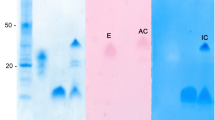Abstract
The rate and extent of insulin degradation by trypsin and α-chymotrypsin were examined in vitro, and the initial sites of cleavage by α-chymotrypsin were identified. The apparent K m for both enzymes was approximately the same but the apparent V max for α-chymotrypsin was 8.6 times greater. At a molar ratio of 172:1 (insulhr.enzyme), chymotrypsin caused near-total loss of insulin within 40 min, while very little insulin was degraded by trypsin. Chymotrypsin appeared to cleave initially at the carboxyl side of the B26-Tyr and A19-Tyr residues, and additional cleavage at the B16-Tyr, B25-Phe, and A14-Tyr residue sites also occurred rapidly. Only two to three other susceptible bonds, which are not exposed at the surface of the insulin molecule, remained intact after the quenching of initial cleavage. Four of the amino acids involved in initial cleavage are essential for receptor binding ability, making it difficult to modify insulin chemically to achieve greater stability without losing activity.
Similar content being viewed by others
REFERENCES
F. Sanger and H. Tuppy. The amino acid sequence in the phenylalanyl chain of insulin. 2. The investigation of peptides from enzymichydrolysates. Biochem. J. 49:481–490 (1951).
D. M. P. Phillips. Further observations on the action of chymotrypsin on insulin. Biochem. J. 49:506–512 (1951).
F. Sanger and E. O. P. Thompson. The amino acid sequence in the glycyl chain of insulin. 2. The investigation of peptides from enzymic hydrolysates. Biochem. J. 53:366–374 (1953).
A. Ginsburg and H. K. Schachman. Studies on the enzymatic breakdown of proteins. I. Action of chymotrypsin on insulin. J. Biol. Chem. 235:108–114 (1960).
J. D. Young and F. H. Carpenter. Isolation and characterization of products formed by the action of trypsin on insulin. J. Biol. Chem. 236:743–748 (1961).
W. W. Bromer and R. E. Chance. Preparation and characterization of desoctapeptide-insulin. Biochim. Biophys. Acta 133:219–223 (1967).
R. J. Schilling and A. K. Mitra. Intestinal mucosal transport of insulin. Int. J. Pharm. 62:53–64 (1990).
M. Laskowski, Jr. Effect of trypsin inhibitor on passage of insulin across the intestinal barrier. Science 127:1115–1116 (1958).
E. Danforth, Jr., and R. O. Moore. Intestinal absorption of insulin in the rat. Endocrinology 65:118–123 (1959).
M. Kidron, H. Bar-On, E. M. Berry, and E. Ziv. The absorption of insulin from various regions of the rat intestine. Life Sci. 31:2837–2841 (1982).
S. Fujii, T. Yokohama, K. Ikegaya, F. Sato, and N. Yokoo. Promoting effect of the new chymotrypsin inhibitor FK-448 on the intestinal absorption of insulin in rats and dogs. J. Pharm. Pharmacol. 37:545–549 (1985).
M. Shinomiya, K. Shirai, Y. Saito, S. Yoshida, and N. Matsuoka. Effect of new chymotrypsin inhibitor (FK-448) on intestinal absorption of insulin. Lancet 2:1092–1093 (1985).
E. Ziv, O. Lior, and M. Kidron. Absorption of protein via the intestinal wall. Biochem. Pharmacol. 36:1035–1039 (1987).
C. W. Crane and G. R. W. N. Luntz. Absorption of insulin from the human small intestine. Diabetes 17:625–627 (1968).
M. J. Balsam, P. G. Holtzapple, R. Kaye, and E. M. Sewell. Intestinal absorption of insulin in patients with fibrocystic disease. J. Pediat. 79:1011–1014 (1971).
Drug Facts and Comparisons, J.B. Lippincott, St. Louis, MO, 1990, p. 130a.
T. L. Blundell, J. F. Cutfield, S. M. Cutfield, E. J. Dodson, G. G. Dodson, D. C. Hodgkin, and D. A. Mercola. Three-Dimensional structure of insulin and its relationship to activity. Diabetes 21(Suppl. 2):492–505 (1972).
Y. Sun and D. L. Smith. Identification of disulfide-containing peptides by performic acid oxidation and mass spectrometry. Anal. Biochem. 172:130–138 (1988).
R. A. Pullen, D. G. Lindsay, S. P. Wood, I. J. Tickle, T. L. Blundell, A. Wormer, G. Krail, D. Brandenburg, H. Zahn, J. Gliemann, and S. Gammeltoft. Receptor-binding region of insulin. Nature 259:369–373 (1976).
M. Kobayashi, S. Ohgaku, M. Iwasaki, H. Maegawa, Y. Shigeta, and K. Inouye. Characterization of [LeuB-24]-and [LeuB-25]-insulin analogues, receptor binding and biological activity. Biochem. J. 206:597–603 (1982).
M. Kobayashi, S. Ohgaku, M. Iwasaki, H. Maegawa, Y. Shigeta, and K. Inouye. Supranormal insulin:[D-PheB24]-insulin with increased affinity for insulin receptors. Biochim. Biophys. Res. Comm. 107:329–336 (1982).
M. Kobayashi, M. Haneda, H. Maegawa, N. Watanabe, Y. Takada, Y. Shigeta, and K. Inouye. Receptor binding and biological activity of [SerB24]-insulin, and abnormal mutant insulin. Biochim. Biophys. Res. Comm. 119:49–57 (1984).
F. B. Stentz, R. K. Wright, and A. E. Kitabchi. A rapid means of separating A-14-I125-insulin from heterogeneously labeled insulin molecules for biologic studies. Diabetes 31:1128–1131 (1982).
T. L. Blundell, G. Dodson, D. Hodgkin, and D. Mercola. Insulin: The structure in the crystal and its reflection in chemistry and biology. In C. B. Anfinsen, Jr., J. T. Edsall, and F. M. Richards (eds.), Adv. Prot. Chem. 26:279–403 (1972).
Author information
Authors and Affiliations
Rights and permissions
About this article
Cite this article
Schilling, R.J., Mitra, A.K. Degradation of Insulin by Trypsin and Alpha-Chymotrypsin. Pharm Res 8, 721–727 (1991). https://doi.org/10.1023/A:1015893832222
Issue Date:
DOI: https://doi.org/10.1023/A:1015893832222




